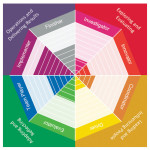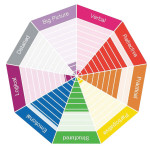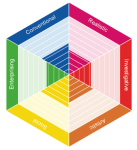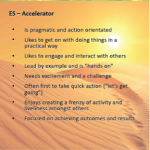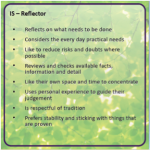Personality Type – The Talent Strengths Type Indicator (TSTI™)
The Talent Strengths Type Indicator™ is the latest evolution in the understanding of personality type. The TSTI™ is a combined Type/Trait instrument that provides a deeper, richer insight into understanding personality type. The TSTI™ takes its foundation from Carl Jung’s Theory of Psychological Type (with the most well-known Jungian instrument being MBTI®). It also draws elements of its foundation from the principle works of trait theorists involved in the development of the Big 5 personality markers.
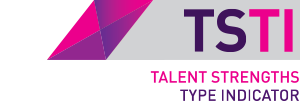
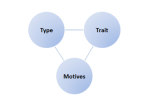
Why is the TSTI™ Different From Other Personality Type Indicators?
The TSTI™ is the first generation of personality type assessments to acknowledge more fully the dynamics of personality. The TSTI™ provides measurement of the traditional 16 personality types (global types) but also 20 underlying facets. Each of the 20 facets have strong convergent and divergent validity with appropriate Big 5 facet scales, giving practitioners greater confidence that they are accurately measuring what each facet purports to measure. By introducing the deeper underlying facets, an individual’s profile can acknowledge the uniqueness of the individual by having elements of their type preferences in both polar opposites of each of the 4 type ranges.
Often a major criticism directed at type indicators is understanding whether it is measuring a person’s subconscious self or some other motivational state that relates to that person’s context at that time (ie. I am at work and therefore I feel I need to be more like this). This may explain why many type indicators show poor test-retest reliability with some 45-50% of people experiencing a different recorded type. The TSTI™ introduces a “Motive” measure by asking respondents to answer each question twice, “What are you” and “What would you like to be”. This gives the respondent permission to consider their motivational preference, thus providing greater accuracy and consistency when they respond to their true type measurement. The combination of having the Facet scales and Motive scoring makes the TSTI™ the most comprehensive type indicator available.
Acknowledging that Carl Jung’s theory does allow for people to operate within the full spectrum of each type scale, despite this, profiled individuals often feel ‘boxed in’ and labelled into becoming one of only 16 types. The TSTI™ provides greater richness and detail about a person such that their profile can include both global and facet scales at different poles and also motive scoring which may be different to their true type. Practitioners are able to discuss the differences between true and motive types exploring the underlying reasons behind their profile results and the degree of impact on the working lives of the individual.
.
A Wider Selection of In-depth Expert Reports
With the increased richness of data provided by the facet scales, the TSTI™ provides a wider range of expert reports where extensive candidate response data can be applied to a variety of popular established research models. The 9 available reports explore such subjects as Leadership Style, Subordinate Reporting Style, Career Preferences, Learning Styles, Creativity and Innovation, Sales Potential, Team Roles and Communication Style.
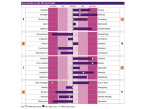
- Stronger theoretical and scientific basis
- Dual type/trait personality measurement
- Global (4 letter) type and lower order facet scores
- Includes motive scoring at global and facet level
- Mapped to a range of established models
- 9 Expert report options for different applications
- Global and motive scoring provide a richer source for feedback
- Improved detail and accuracy
- Excellent toolkit for coaching and facilitation
- Choice of models to Multi-level profile for choice of detail

Team Roles Report
Applications
The Team Roles Report uses a work structured context for exploring individual team roles and their contribution to team performance and effectiveness. Ideal for:
Team Working
Helping team members to understand their role strengths and their potential contribution to achieving optimal performance as a team.
Innovation and Problem Solving
In understanding each person’s role and strengths, teams can deliver better more focussed problem solving.
Team Balance
Helps to evaluate where there may be role gaps or an imbalance in the team.
Enhancing Team Performance
Understanding their team strengths and where individuals are ideally placed to contribute to the team’s performance.
Change management
Helping team members receive feedback about their role and their potential input to future planning.
Benefits
Improved Team Performance
Teams with clear roles and goals work better to deliver higher performance levels.
Performance Climate
Teams that are clear about their shared objectives and their role in delivery are more likely to create a healthy performance climate.
Balanced Decision Making
The wider group’s views are considered to ensure the best ideas aren’t lost.
Reduced Interpersonal Conflict
Improved understanding of others’ strengths, roles and contribution to team performance.

Selling Styles Report
Selling Styles Report
Applications
The Selling Styles Report looks in detail at the six stages of the sales cycle, exploring a person’s potential when operating in key sales tasks and activities. Ideal for:
Sales Coaching
Supporting sales people in understanding their strengths and limitations and how to become more effective when selling.
Building New Sales Teams
Helping to identify and match roles to the right individuals.
Training Needs Analysis
Identifying where extra support or training is required.
Developing Self Awareness
Helping sales people understand how they are perceived by others.
Benefits
Better and More Effective Sales People
Individuals who understand their strengths in the sale process and where they can be most effective.
Focussed Sales Training
Profiling helps target specific areas requiring additional training and personal development.
Improved Selling Skills
Focussed advice enables individuals to make better choices and decisions at each stage of the sales process.
Better Retention
Sales people can be identified for roles where there is a more suitable match of skills to the job requirements.
The Report
The report looks in detail at 24 sales activities that underpin the 6 stages of the sales cycle. An individual’s potential is considered against known characteristics of successful sales people in various sales situations.
The report includes a full colour profile of their preferred subordinate styles and communication style. Also displayed is their 4 Colours (quadrant) summary which can be beneficial for team building activities.
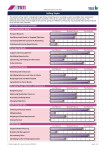

The 7 Creativity Lenses™ Report
The 7 Creativity Lenses™ Report provides a framework for exploring a person’s approach to creativity and for identifying their strengths and preferences. Ideal for:
Brainstorming
Helping groups and individuals consider wider issues and options when exploring new ideas.
Meetings
Enables groups in meetings to evaluate ideas constructively and with greater balance.
Team Working
Helping team members to understand individual differences and their potential contribution to the creative process.
Enhancing Team Performance
Understanding team strengths and where individuals are ideally placed to contribute in creating new ideas.
Change Management
Change requires new ideas and ways of working with input from people affected by changes in order that they buy into new solutions. Using the lenses helps keep all input positive and constructive.
Benefits
Quick and easy
Completed in 10-15 minutes.
Better Creativity
A formalised approach to ensure ideas are evaluated more accurately.
Balanced Decision Making
Wider views considered to ensure the best ideas aren’t lost.
Reduced Interpersonal Conflict
Improved understanding of others’ strengths and contribution to creativity.

Learning Styles Report
The Learning Styles Report looks at 9 different learning styles that identify how a person prefers to learn and how they approach understanding new information. Ideal for:
Training Courses
Preparing individuals for new learning content and understanding how they take in new information.
Apprenticeships
By understanding how apprentices learn, training material can be adapted and made more interesting and engaging for the individual.
Individual Coaching
In a 1 to 1 situation it is extremely valuable to understand how a person processes information when learning. This knowledge is helpful for a coaching when providing advice.
Group Facilitation
Understanding how others in your group prefer to learn can be helpful when people work together. Exploring this as a group can improve interpersonal understanding enabling groups to be more productive together.
Benefits
More productive Employees
Individuals who understand how they learn can apply themselves to tasks more effectively. Managers who understand employee learning styles are better equipped to support and personalise how they work with each person.
Behavioural Change
Insightful feedback and improved self-awareness of personal learning styles by employees can help them adapt their behaviour to circumstances when necessary.
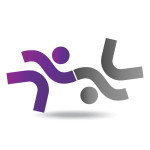
Leadership and Management Report
The Leadership and Management Styles Report explores a person’s preferred style of leading and managing others with detailed coaching advice and insights. Ideal for:
Leadership Development
Helping leaders understand their preferred style of leadership and how to optimise their performance in the workplace.
1 to 1 Coaching
Supporting managers and leaders in understanding how they impact others and how to manage more effectively.
Identifying Leadership Potential
Helping team leaders and individual contributors within the organisation explore their future leadership and management potential.
Development Centres
This TSTI™ report provides a rich source of information to support other data gathered during a development centre.
Cultural Change
Change needs to be driven from the top. Exploring managers’ and leaders’ preferred style of leadership can help them make changes to their style to suit the organisation’s future direction and expected behaviours.
Benefits
Better Leaders and Managers
Leaders and managers who are more self-aware and able to harness their authority and skills more effectively.
Improved Leadership Succession
Managers and junior leaders can assume new roles with greater self-awareness and confidence.
The Report
The report is anchored by well-established leadership models covering both leadership and reporting (subordinate) styles. Further insights are extracted from a person’s facet profile, delivering a sophisticated level of detail unrivalled by any type indicator.
The report also includes information about their Team roles, Creativity Lens preferences and Communication Style. As with all the TSTI™ reports, a summary profile of the person’s global and facet types is provided.
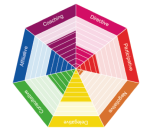

Career Interests Report
The Career Interests Report highlights a person’s preferred career themes and helps explore the underlying work environment and activities that they may find most suitable. Ideal for:
Career Coaching
Supporting people who are seeking or starting a new career.
Career Transition
Useful tools for helping those who may be at a career crossroads and considering a career change.
Outplacement
Supporting organisations that may be going through change or downsizing and want to provide resettlement support for those affected.
Benefits
Better Career Fit
Individuals who are happier and better suited to their job.
Smoother Organisational Change
Helping individuals who are going through career transition to make the right choices for their future welfare and happiness.

The 4 Colours™ (Quadrants) Report
The 4 Colours™ Report provides a simplified type model based on the TSTI™ type quadrants, designed to help introduce groups and teams to the dynamics of personality type.
Team Building
Helping to understand individual differences and diversity in teams.
Enhancing Team Performance
Understanding team strengths and the uniqueness of team members and their preferences.
Communication
Understanding each others’ communications style to improve inter- personal understanding.
Ice Breaker
Quick and easy way to facilitate and integrate new people.
Individual Development
Helping individuals understand their natural work style and type.
Change Management
Exploring type as a catalyst for behavioural change and cultural change.
Benefits
Simplicity
A simple model to facilitate and to engage groups in understanding each other.
Compares Current with Motive Score
Deeper insight into current preference versus aspirational (motive) type.
Improved Team Performance
Delivers better team working, task allocation and collaboration.
Improved Communication and Engagement
Individuals understand each other better and the model helps colleagues to work more closely with each other

